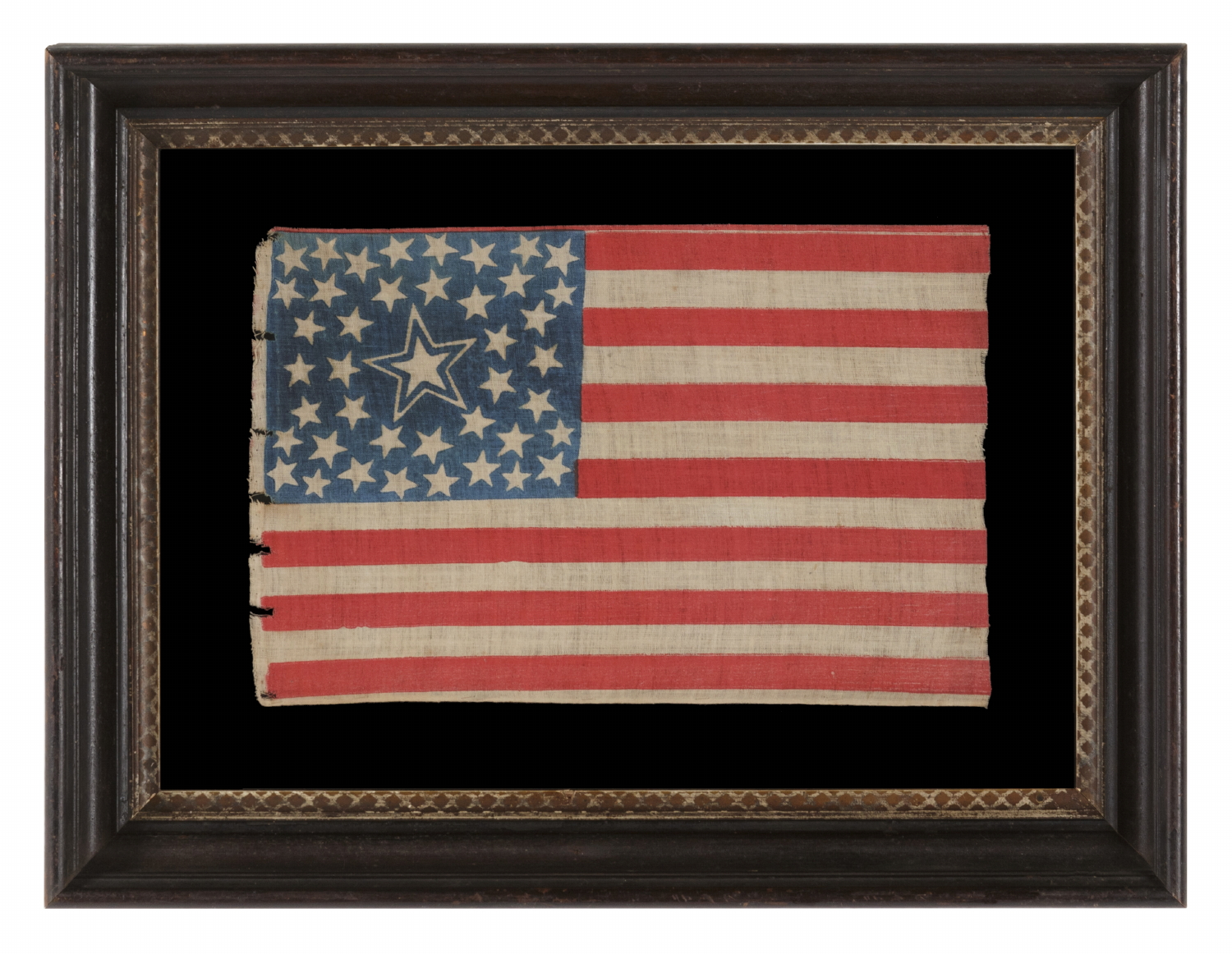
| |
42 STARS IN A MEDALLION CONFIGURATION. WITH A LARGE, HALOED CENTER STAR AND A TRIO OF 3 STARS IN EACH CORNER, ON AN EXCEPTIONALLY RARE ANTIQUE AMERICAN PARADE FLAG, WASHINGTON STATEHOOD, circa 1889-1890 |
|
| Available: |
Sold |
| Frame Size (H x L): |
17.25" x 23" |
| Flag Size (H x L): |
10" x 14.75" |
|
| Description....: |
|
42 star American parade flag, printed on cotton, with an exceptionally unusual form of the medallion configuration that features a large center star with a pinstriped halo around its perimeter and 3 flanking stars in each corner of the blue canton. There is typically only one star in each corner of a medallion design. The presence of more than one star can be seen on rare occasion in flags with sewn construction, but is practically never seen in printed parade flags. Note how the stars in the corners appear in 2 different sizes, which is equally beautiful and rare.
This very rare design appears in two sizes, of which this is the smaller. Just a small handful of examples are known to exist in total between the two varieties. One of these is documented in "The Stars & The Stripes: Fabric of the American Spirit" by Richard Pierce (J. Richard Pierce, LLC, 2005), p. 19.
Although the maker that produced these flags is unknown, parade flags with a haloed center star exist in at least five other star counts including 30, 31, 34, 35, and 36. Three examples also exist, probably from different makers, that bear 13 stars. One dates to 1856 and was made for the presidential campaign of James Buchanan. Another was made for the 1860 presidential campaign of John Bell, who ran against Abraham Lincoln, as an independent, on the Constitutional Union Party ticket. Another style, printed on a wool and cotton blended fabric, dates to the 1876 centennial and all of its 13 stars have halos.
The 42 star flag is interesting from a historical perspective, both because 42 was never an official star count, and because 42 star flags were only produced for about 8 months (November, 1889 – July 4th, 1890). The flag represents the addition of the Dakotas, Montana and Washington State, between November 2nd and November 11th, 1889. The 42nd state was officially Washington, but the four states gained their statehood only nine days apart, and flag makers added 4 stars, accordingly, to the count of 38 that was official at the time.
After 1818, star counts became official on the 4th of July each year. A new star was therefore officially added on Independence Day for every state that had been added over the preceding “flag year”. Flag makers, however, did not wait for July 4th and official star counts. Flag production was a competitive industry and no one wanted to be making 38 star flags, for example, when their competitors were making 42 star examples and there were 42 states.
Idaho joined the Union on July 3rd, 1890, taking the star count to 43 just one day before 42 would have become the official number. This fact makes 42 star flags an interesting part of our heritage and a classic display of American capitalism.
Mounting: The black-painted molding dates to the period between 1800 and 1850. The flag has been hand-stitched to 100% cotton, black in color, which was washed to reduce excess dye. An acid-free agent was added to the wash to further set the dye and the fabric was heat-treated for the same purpose. Spacers keep the textile away from the glazing, which is U.V. protective glass.
Condition: There is craquelure and associated pigment loss throughout. There is very minor staining and there is minor fabric loss, particularly located along the hoist end. Many of my clients prefer early flags to show their age and history of use. |
|
|
|
| Collector Level: |
Advanced Collectors and the Person with Everything |
|
| Flag Type: |
Parade flag |
|
| Star Count: |
42 |
|
| Earliest Date of Origin: |
1889 |
|
| Latest Date of Origin: |
1890 |
|
| State/Affiliation: |
Washington |
|
| War Association: |
1866-1890 Indian Wars |
|
| Price: |
SOLD |
|
| |
Views: 1321 |
|
|
|

